Family name: Convolvulaceae Jussieu
Synonym(s): Cuscutaceae Dumort., nom. cons.; Dichondraceae Dumort., nom. cons.; Erycibaceae Endl. ex Meisn.; Humbertiaceae Pichon, nom. cons.; Poranaceae J. Agardh
Common name(s): morning-glory family
*Number of genera/species: 60/1,660
List of genera records in GRIN-Global
Note: Cuscuta fruit and seed morphology is unique within the family and treated separately below.
Fruit usually a loculicidalloculicidal:
type of capsular dehiscence, opening longitudinally through the locules (compare septicidal)
 capsulecapsule:
capsulecapsule:
a dry, dehiscent fruit derived from a compound ovary , sometimes circumscissilecircumscissile:
, sometimes circumscissilecircumscissile:
(~pyxis); type of capsular dehiscence, opens by a lid (splitting transversely)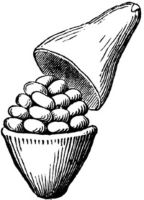 (Dichondra, Merremia, Operculina) or irregular, rarely indehiscentindehiscent:
(Dichondra, Merremia, Operculina) or irregular, rarely indehiscentindehiscent:
not opening on its own, as in a fruit
 berryberry:
berryberry:
an indehiscent, fleshy fruit with one or a few to many seeds. The flesh may be homogenous throughout. Or, if the outer part is hard, firm, or leathery, referred to as an hesperidium. Septa are present in some, and the seeds may be arillate or with a fleshy testa. (Argyreia, Erycibe) or nutlike fruit (e.g. Dicranostyles, Maripa), 2–40 mm long, globoseglobose:
(Argyreia, Erycibe) or nutlike fruit (e.g. Dicranostyles, Maripa), 2–40 mm long, globoseglobose:
3D shape—more or less spherical , often oblateoblate:
, often oblateoblate:
depressed globose
or 2–4 lobed to oblongoblong:
2D shape—much longer than broad with nearly parallel sides, corners are rounded , rarely trigonoustrigonous:
, rarely trigonoustrigonous:
3D shape—having three faces that meet at distinct angles; triangular in outline
, tereteterete:
approximately circular in cross section; width and thickness approximately equal
 in transection, stylestyle:
in transection, stylestyle:
in a flower, the narrow and elongated part of the pistil between the stigma and the ovary; sometimes persisting in fruit persistent, usually with 2–4 seeds, except 1-seeded in nutlike fruits, usually subtended or enclosed by persistent, often accrescentaccrescent:
persistent, usually with 2–4 seeds, except 1-seeded in nutlike fruits, usually subtended or enclosed by persistent, often accrescentaccrescent:
growing continuously
, calyxcalyx:
the outer whorl of the perianth; all the sepals of a flower . Pericarppericarp:
. Pericarppericarp:
fruit wall or fruit coat
usually black or brown (all shades), sometimes dark purple, red, orange, yellow or striped, shinyshiny:
uniformly reflecting a high proportion of incident light at all angles or dulldull:
or dulldull:
reflecting only a low proportion of incident light, with no apparent sheen , glabrousglabrous:
, glabrousglabrous:
without hairs
or pubescentpubescent:
surface relief—bearing hairs
, smooth. Pericarppericarp:
fruit wall or fruit coat
texture varies with fruit type.
Seeds globoseglobose:
3D shape—more or less spherical to angularangular:
to angularangular:
2D shape—having sides that meet at acute or obtuse angles
, frequently sectoroidsectoroid:
3D shape—a wedge-shaped slice taken from an ovoid or globose structure (2D shape, sector-shaped)
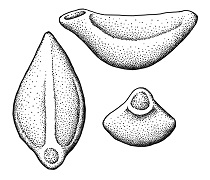 , 1–15 mm long. Rarely winged. Seed coat usually black or brown, shinyshiny:
, 1–15 mm long. Rarely winged. Seed coat usually black or brown, shinyshiny:
uniformly reflecting a high proportion of incident light at all angles or dulldull:
or dulldull:
reflecting only a low proportion of incident light, with no apparent sheen , usually thick and hard (bonybony:
, usually thick and hard (bonybony:
very hard and rather brittle, like bone
), usually sparsely to densely pubescentpubescent:
surface relief—bearing hairs
, may appear woolly, smooth or longitudinally keeledkeel:
a longitudinal ridge, like the keel of a boat, formed by the lengthwise folding of a structure, such as a lemma or palea
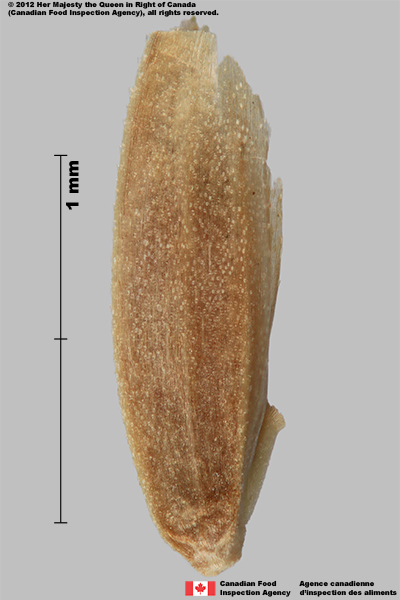 , areolate, wrinkledwrinkled:
, areolate, wrinkledwrinkled:
surface relief—shallow, irregular folds and furrows covering the surface; appearing overall though crumpled and then spread out , or wartywarty:
, or wartywarty:
surface relief—distinct, rounded projections that are large relative to the fruit size; tuberculate, verrucose . Hila punctate or if larger than punctatepunctate:
. Hila punctate or if larger than punctatepunctate:
surface relief—dotted with pits or with translucent, sunken glands or with colored dots, similar to pitted , circularcircular:
, circularcircular:
(of embryo) linear embryo is curved into an "O" shape or nearly so, terminal or almost terminal on angledangular:
or nearly so, terminal or almost terminal on angledangular:
2D shape—having sides that meet at acute or obtuse angles
side, sometimes surrounded by omega-shaped rim.
Embryo well developed, large, green, partially filling seed coat, axil and centric, foliatefoliate:
appearing leaf-like
linearlinear:
(shape) long, narrow, and uniform in width; (of embryo) embryo is straight and much longer than wide ) Nephrophyllum), straight or curvedcurved:
) Nephrophyllum), straight or curvedcurved:
(of embryo) linear embryo is curved into an arch or horseshoe with the ends far apart , embedded in endosperm. Cotyledons well developed, 0.6–0.9 length relative to the embryo, folded, apexapex:
, embedded in endosperm. Cotyledons well developed, 0.6–0.9 length relative to the embryo, folded, apexapex:
the point farthest from the point of attachment, or the "tip" of an organ emarginate, bifidbifid:
emarginate, bifidbifid:
two-lobed or two-cleft (usually in reference to an apex)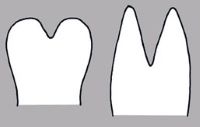 , or cleft, sometimes punctatepunctate:
, or cleft, sometimes punctatepunctate:
surface relief—dotted with pits or with translucent, sunken glands or with colored dots, similar to pitted dotted.
dotted.
Endosperm moderate to scanty, hard, cartilaginouscartilaginous:
texture—firm, dense, tough, somewhat pliable, and resilient, like cartilage
, and smooth.
Cuscuta
Fruit usually a circumscissilecircumscissile:
(~pyxis); type of capsular dehiscence, opens by a lid (splitting transversely) capsulecapsule:
capsulecapsule:
a dry, dehiscent fruit derived from a compound ovary , often opening near the base, sometimes dehiscing irregularly or indehiscentindehiscent:
, often opening near the base, sometimes dehiscing irregularly or indehiscentindehiscent:
not opening on its own, as in a fruit
 and berry-like, 0.9–6.3 mm long, globoseglobose:
and berry-like, 0.9–6.3 mm long, globoseglobose:
3D shape—more or less spherical , ellipsoidellipsoid:
, ellipsoidellipsoid:
3D shape—elliptic
, ovoidovoid:
3D shape—ovate , or thimble-shaped, tereteterete:
, or thimble-shaped, tereteterete:
approximately circular in cross section; width and thickness approximately equal
 in transection, stylesstyle:
in transection, stylesstyle:
in a flower, the narrow and elongated part of the pistil between the stigma and the ovary; sometimes persisting in fruit persistent and divergent, with 1–4 seeds, calyxcalyx:
persistent and divergent, with 1–4 seeds, calyxcalyx:
the outer whorl of the perianth; all the sepals of a flower lobes persistent usually at or near the apexapex:
lobes persistent usually at or near the apexapex:
the point farthest from the point of attachment, or the "tip" of an organ , sometimes withered corollacorolla:
, sometimes withered corollacorolla:
the inner whorl(s) of the perianth; all the petals of a flower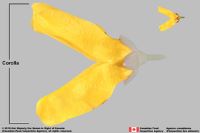 also present. Pericarppericarp:
also present. Pericarppericarp:
fruit wall or fruit coat
brown, dulldull:
reflecting only a low proportion of incident light, with no apparent sheen , dry or sometimes fleshy, glabrousglabrous:
, dry or sometimes fleshy, glabrousglabrous:
without hairs
, often papillatepapillate:
surface relief—bearing minute, distinct, broad-based projections, tapering to a rounded apex .
.
Seeds dorsoventrally compressedcompressed:
flattened; in grasses, used to denote compression (not necessarily flattened) either laterally or dorsiventrally
(one flat and one convex side), angledangular:
2D shape—having sides that meet at acute or obtuse angles
, or no compression, globoseglobose:
3D shape—more or less spherical to oblongoblong:
to oblongoblong:
2D shape—much longer than broad with nearly parallel sides, corners are rounded , plano-convexplano-convex:
, plano-convexplano-convex:
2D or 3D shape—flat on one side, convex on the other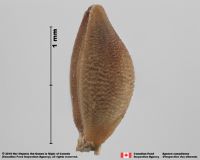 , compressedcompressed:
, compressedcompressed:
flattened; in grasses, used to denote compression (not necessarily flattened) either laterally or dorsiventrally
or tereteterete:
approximately circular in cross section; width and thickness approximately equal
 in transection, 0.7–3.2 mm long. Seed coat brown or gray, dulldull:
in transection, 0.7–3.2 mm long. Seed coat brown or gray, dulldull:
reflecting only a low proportion of incident light, with no apparent sheen , glabrousglabrous:
, glabrousglabrous:
without hairs
, smooth or roughenedroughened:
texture—having a small, stout, stiff, more or less acute protrusions
, alveolatealveolate:
surface relief—reticulated, honeycombed; ridges that intersect to form polygonal cells with a regular size and shape similar to a honeycomb , scurfy, wartywarty:
, scurfy, wartywarty:
surface relief—distinct, rounded projections that are large relative to the fruit size; tuberculate, verrucose or pittedpitted:
or pittedpitted:
surface relief—surface with small depressions in which the areas between the hollows do not take on the appearance of a true reticular net . Hila larger than punctatepunctate:
. Hila larger than punctatepunctate:
surface relief—dotted with pits or with translucent, sunken glands or with colored dots, similar to pitted and circularcircular:
and circularcircular:
(of embryo) linear embryo is curved into an "O" shape .
.
Embryo rudimentaryrudimentary:
(of embryo) embryo is small and fills less than a quarter of the seed and can be variable in shapes, such as linear, spatulate, or oval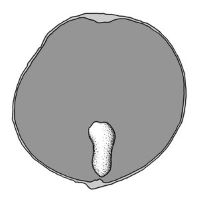 to weakly differentiated, green, peripheralperipheral:
to weakly differentiated, green, peripheralperipheral:
(of embryo) embryo is curved around the outer edge of the seed, near the seed coat
, filiform, flatly or conically coiledcoiled:
(of embryo) linear embryo is very long and bent to form a coil whereby one end of the embryo is on the outside and the other end near the middle of the seed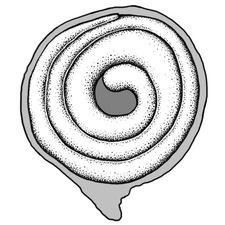 or annularannular:
or annularannular:
3D shape—forming a ring , strongly curvedcurved:
, strongly curvedcurved:
(of embryo) linear embryo is curved into an arch or horseshoe with the ends far apart around endosperm, acotyledonous or nearly so.
around endosperm, acotyledonous or nearly so.
Endosperm moderate, hard, smooth.
Noxious Weeds or regulated taxa: USA Federal Noxious Weed List, terrestrial, Cuscuta spp.; aquatic, Ipomoea aquatica Forssk.
Federal Noxious Weed Disseminules of the US ID tool provides keys, descriptions, and images of these species. Aquarium & Pond Plants of the World tool includes descriptions and images of aquatic Ipomoea.
| Fruit | Convolvulaceae, except Cuscuta |
| Type | capsulecapsule: a dry, dehiscent fruit derived from a compound ovary  , berryberry: , berryberry:an indehiscent, fleshy fruit with one or a few to many seeds. The flesh may be homogenous throughout. Or, if the outer part is hard, firm, or leathery, referred to as an hesperidium. Septa are present in some, and the seeds may be arillate or with a fleshy testa.  , nut-like , nut-like |
| Size range | 2–40 mm long |
| Shape(s) | globoseglobose: 3D shape—more or less spherical  often oblateoblate: often oblateoblate:depressed globose or 2–4 lobed, broadly conicalconical: 3D shape—cone-shaped, with the point of attachment at the broad end 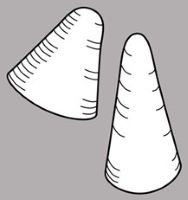 , ellipsoidellipsoid: , ellipsoidellipsoid:3D shape—elliptic , ovoidovoid: 3D shape—ovate  , oblongoblong: , oblongoblong:2D shape—much longer than broad with nearly parallel sides, corners are rounded  , rarely trigonoustrigonous: , rarely trigonoustrigonous:3D shape—having three faces that meet at distinct angles; triangular in outline |
| Texture | berriesberry: an indehiscent, fleshy fruit with one or a few to many seeds. The flesh may be homogenous throughout. Or, if the outer part is hard, firm, or leathery, referred to as an hesperidium. Septa are present in some, and the seeds may be arillate or with a fleshy testa.  - fleshy, mealymealy: - fleshy, mealymealy:loose, dry, and disintegrating in finely granular pieces like meal or flour , leatheryleathery: texture—moderately thick, tough, and very pliable capsules - membranousmembranous: texture—extremely thin, pliable, and fairly tough , paperypapery: texture—papyraceous, chartaceous; very thin, pliable, and readily torn; like paper , woodywoody: texture—consisting mainly of indurate lignified tissues, characteristic of or resembling wood , leatheryleathery: texture—moderately thick, tough, and very pliable nut-like fruits - usually hard, woodywoody: texture—consisting mainly of indurate lignified tissues, characteristic of or resembling wood , leatheryleathery: texture—moderately thick, tough, and very pliable |
| Surface relief | smooth |
| Color(s) | black or brown (all shades), sometimes dark purple, red, orange, yellow or striped |
| Unique features | Usually, small, smooth loculicidalloculicidal: type of capsular dehiscence, opening longitudinally through the locules (compare septicidal)  capsulescapsule: capsulescapsule:a dry, dehiscent fruit derived from a compound ovary  , sometimes circumscissilecircumscissile: , sometimes circumscissilecircumscissile:(~pyxis); type of capsular dehiscence, opens by a lid (splitting transversely)  , with 4–8 valves and 2 or 4 often hairy seeds with bonybony: , with 4–8 valves and 2 or 4 often hairy seeds with bonybony:very hard and rather brittle, like bone seed coats. |
| Seed | |
| Size range | 1–15 mm long |
| Shape(s) | globoseglobose: 3D shape—more or less spherical  , ovoidovoid: , ovoidovoid:3D shape—ovate  , pear-shaped, ellipsoidellipsoid: , pear-shaped, ellipsoidellipsoid:3D shape—elliptic , fusiformfusiform: spindle-shaped; broadest at the middle and tapering at both ends  , trigonoustrigonous: , trigonoustrigonous:3D shape—having three faces that meet at distinct angles; triangular in outline , angularangular: 2D shape—having sides that meet at acute or obtuse angles |
| Surface relief | smooth, longitudinally keeledkeel: a longitudinal ridge, like the keel of a boat, formed by the lengthwise folding of a structure, such as a lemma or palea  , areolate, wartywarty: , areolate, wartywarty:surface relief—distinct, rounded projections that are large relative to the fruit size; tuberculate, verrucose  , wrinkledwrinkled: , wrinkledwrinkled:surface relief—shallow, irregular folds and furrows covering the surface; appearing overall though crumpled and then spread out  |
| Color(s) | black, brown (all shades), purplish black, gray, red-brown, yellow, orange |
| Unique features | Usually dark seeds, often conspicuously pubescentpubescent: surface relief—bearing hairs with circularcircular: (of embryo) linear embryo is curved into an "O" shape  hila and with large, green embryos embedded in hard, cartilaginouscartilaginous: hila and with large, green embryos embedded in hard, cartilaginouscartilaginous:texture—firm, dense, tough, somewhat pliable, and resilient, like cartilage endosperm. HilaHilum: on seeds, the scar indicating where the funiculus was attached; on grass caryopses, the scar visible on the outer fruit surface revealing where the seed is attached on the inner fruit wall surface; or in Asteraceae cypselae, the scar visible on the outer fruit wall revealing where the fruit was attached to the receptacle  may be surrounded by omega-shaped rim. may be surrounded by omega-shaped rim. |
| Other | |
| Embryo | well developed, large, green, partially filling seed coat, axil and centric, foliatefoliate: appearing leaf-like linearlinear: (shape) long, narrow, and uniform in width; (of embryo) embryo is straight and much longer than wide  ) Nephrophyllum), straight or curvedcurved: ) Nephrophyllum), straight or curvedcurved:(of embryo) linear embryo is curved into an arch or horseshoe with the ends far apart  , with well-developed, folded emarginateemarginate: , with well-developed, folded emarginateemarginate:with a shallow notch at apex 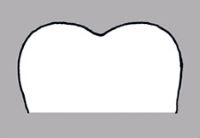 or bifidbifid: or bifidbifid:two-lobed or two-cleft (usually in reference to an apex)  cotyledons cotyledons |
| Nutritive tissue | endosperm moderate to scanty, hard, cartilaginouscartilaginous: texture—firm, dense, tough, somewhat pliable, and resilient, like cartilage , and smooth |
| Fruit | Cuscuta |
| Type | capsulecapsule: a dry, dehiscent fruit derived from a compound ovary  |
| Size range | 0.9–6.3 mm long |
| Shape(s) | globoseglobose: 3D shape—more or less spherical  ellipsoidellipsoid: ellipsoidellipsoid:3D shape—elliptic , ovoidovoid: 3D shape—ovate  , thimble-shaped , thimble-shaped |
| Texture | dry, somewhat fleshy |
| Surface relief | often papillatepapillate: surface relief—bearing minute, distinct, broad-based projections, tapering to a rounded apex  |
| Color(s) | brown |
| Unique features | Very small, often papillatepapillate: surface relief—bearing minute, distinct, broad-based projections, tapering to a rounded apex  circumscissilecircumscissile: circumscissilecircumscissile:(~pyxis); type of capsular dehiscence, opens by a lid (splitting transversely)  capsulescapsule: capsulescapsule:a dry, dehiscent fruit derived from a compound ovary  with 1–4 glabrousglabrous: with 1–4 glabrousglabrous:without hairs seeds with coiledcoiled: (of embryo) linear embryo is very long and bent to form a coil whereby one end of the embryo is on the outside and the other end near the middle of the seed  , filiform, green embryos. , filiform, green embryos. |
| Seed | |
| Size range | 0.7–3.2 mm long |
| Shape(s) | globoseglobose: 3D shape—more or less spherical  , ellipsoidellipsoid: , ellipsoidellipsoid:3D shape—elliptic , ovoidovoid: 3D shape—ovate  , oblongoblong: , oblongoblong:2D shape—much longer than broad with nearly parallel sides, corners are rounded  , irregular, mitaformmitaform: , irregular, mitaformmitaform:shaped like a child's mitten |
| Surface relief | smooth, roughenedroughened: texture—having a small, stout, stiff, more or less acute protrusions , alveolatealveolate: surface relief—reticulated, honeycombed; ridges that intersect to form polygonal cells with a regular size and shape similar to a honeycomb  , scurfy, wartywarty: , scurfy, wartywarty:surface relief—distinct, rounded projections that are large relative to the fruit size; tuberculate, verrucose  , pittedpitted: , pittedpitted:surface relief—surface with small depressions in which the areas between the hollows do not take on the appearance of a true reticular net  |
| Color(s) | brown, gray |
| Unique features | Brown or gray, glabrousglabrous: without hairs seeds with circularcircular: (of embryo) linear embryo is curved into an "O" shape  hila and filiform, green, acotyledonous, peripheralperipheral: hila and filiform, green, acotyledonous, peripheralperipheral:(of embryo) embryo is curved around the outer edge of the seed, near the seed coat embryos curvedcurved: (of embryo) linear embryo is curved into an arch or horseshoe with the ends far apart  around the embryo. around the embryo. |
| Other | |
| Embryo | rudimentaryrudimentary: (of embryo) embryo is small and fills less than a quarter of the seed and can be variable in shapes, such as linear, spatulate, or oval  to weakly differentiated, green, peripheralperipheral: to weakly differentiated, green, peripheralperipheral:(of embryo) embryo is curved around the outer edge of the seed, near the seed coat , filiform, flatly or conically coiledcoiled: (of embryo) linear embryo is very long and bent to form a coil whereby one end of the embryo is on the outside and the other end near the middle of the seed  or annularannular: or annularannular:3D shape—forming a ring  , strongly curvedcurved: , strongly curvedcurved:(of embryo) linear embryo is curved into an arch or horseshoe with the ends far apart  around endosperm, acotyledonous or nearly so around endosperm, acotyledonous or nearly so |
| Nutritive tissue | endosperm moderate, hard, smooth |
Worldwide, primarily in subtropical regions of Asia and America.
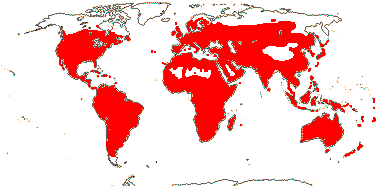
Distribution map courtesy of Angiosperm Phylogeny Website.
Goldberg 1986Goldberg 1986:
Goldberg A. 1986. Classification, Evolution, and Phylogeny of the Families of Dicotyledons. Smithsonian Contributions to Botany. pp 314. https://doi.org/10.5479/si.0081024X.58; Ho 2017Ho 2017:
Ho A. 2017. Diversity and evolution of fruits in Cuscuta (dodders; Convolvulaceae). Master’s thesis, Wilfrid Laurier University, Theses and Dissertations (Comprehensive). 1979. https://scholars.wlu.ca/etd/1979; Kirkbride et al. 2006Kirkbride et al. 2006:
Kirkbride JH, Jr, Gunn CR, and Dallwitz MJ. 2006. Family guide for fruits and seeds, vers. 1.0. Accessed September 2020-January 2022. URL: https://nt.ars-grin.gov/seedsfruits/keys/frsdfam/index.cfm .; Martin 1946Martin 1946:
Martin AC. 1946. The comparative internal morphology of seeds. American Midland Naturalist 36 (3): 513-660. https://doi.org/10.2307/2421457; Noxious Weed Regulations 2020Noxious Weed Regulations 2020:
Noxious Weed Regulations. 2020. 7 C.F.R. sect; 360.100-360.600.; Olszewski et al. 2020Olszewski et al. 2020:
Olszewski M, Dilliott M, García-Ruiz I, Bendarvandi B, and Costea M. 2020. Cuscuta seeds: Diversity and evolution, value for systematics/identification and exploration of allometric relationships. PLoS One 15(6): e0234627. doi: 10.1371/journal.pone.0234627.; Staples et al. 2020Staples et al. 2020:
Staples GW, Simões AR, and Austin DF. 2020. A monograph of Operculina (Convolvulaceae). Annals Missouri Botanical Garden 105, 64&-138. doi: 10.3417/2020435; Takhtajan 2009Takhtajan 2009:
Takhtajan A. 2009. Flowering plants: Second edition. Springer Nature, Switzerland. 871 pp.; USDA 1980USDA 1980:
United States Dept. of Agriculture (USDA). 1980. Major weed family identification guide. Hyattsville Md, United States ; Zhengyi et al. 2004+Zhengyi et al. 2004+:
Zhengyi W, Raven PH, and Deyuan H. 2004+. Flora of China [online]. 25 vols. Science Press, Beijing China & Missouri Botanical Garden, St. Louis USA. Accessed January–March 2024. http://flora.huh.harvard.edu/china/
*The number of genera and species is based on Christenhusz and Byng 2016Christenhusz and Byng 2016:
Christenhusz MJM and Byng JW. 2016. The number of known plant species in the world and its annual increase. Phytotaxa 261 (3): 201-217. https://doi.org/10.11646/phytotaxa.261.3.1, which may differ from the number of genera in GRIN-Global.